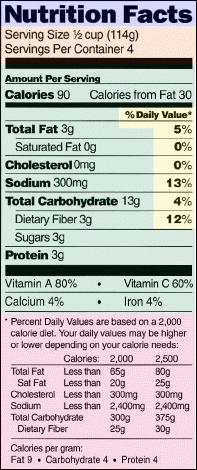Top Categories
Customer Service
|
Nutrition Labels on Food Packages Explained
 The new nutrition labels on food packages is an effort to simplify and encourage the use of nutritional information. It's clear, informative, and detailed, providing everything a consumer would normally need to decide if a food meets their nutritional standards before buying.
Nutrients
The common nutrients, such as Total Fat, Cholesterol, and Sodium, are required fields. Other nutrients, such as Iron and Vitamin K, are optional and not required to be listed.
Serving Size
Serving size tries to reflect the amount a person can eat. It must be about the same for like products, which makes it easier to compare the nutritional qualities of related foods. Serving sizes are expressed in both common household and metric measures.
Percent Daily Values
Percent Daily Values" tell the levels of important nutrients in a food and how those amounts fit into a daily diet. Percent Daily value is determined on the basis of a 2,000 calorie diet (see below on the label). For example, the total fat of a product is 3 g, and the 2,000 calorie diet permits 65 grams a day. A simple math procedure would consist of 3g / 65g x 100 Percent = 4.62 Percent or about 5 Percent, which the food label lists. So, now instead of making all the calculations, the Percent Daily Value column has all the answers. It simply states that the given food contains 5 Percent out of 100 Percent of a daily value.
DRV Footnote
This footnote reminds consumers of the daily intake of different foods depending on their caloric needs. If one pursues a 2,000 calorie diet, he/she must eat the indicated amounts noted on the right of nutrients noted on the left side of the footnote. For example, if Anne's daily calorie intake is 2,500 grams, her RDAs would be -- 50g of fat, with less than 25g of saturated fat and less than 300 mg of cholesterol, etc. Kelly's calorie intake is 3,000 grams, she's slightly more active than Anne. Therefore, her nutrient needs will may be slightly higher. That is what is meant by the phrase "your daily values may be higher or lower depending on your caloric needs."
Nutrient Content Descriptors
The regulations also spell out what terms may be used to describe the level of a nutrient in a food and how they can be used.
These are the core terms:
-
Free. This term means that a product contains no amount of, or only trivial or "physiologically inconsequential" amounts of, one or more of these components: fat, saturated fat, cholesterol, sodium, sugars, and calories. For example, "calorie-free" means fewer than 5 calories per serving and "sugar-free" and "fat-free" both mean less than 0.5 g per serving. Synonyms for "free" include "without," "no" and "zero."
-
Low. This term can be used on foods that can be eaten frequently without exceeding dietary guidelines for one or more of these components: fat, saturated fat, cholesterol, sodium, and calories. Thus, descriptors are defined as follows:
-
low-fat: 3g or less per serving
-
low-saturated fat: 1 g or less per serving
-
low-sodium: 140mg or less per serving
-
very low sodium: 35mg or less per serving
-
low-cholesterol: 20mg or less and 2 g or less of saturated fat per serving
-
low-calorie: 40 calories or less per serving.Synonyms for low include "little," "few," and "low source of."
-
Lean and extra lean. These terms can be used to describe the fat content of meat, poultry, seafood, and game meats.
-
Lean: less than 10g fat, 4.5g or less saturated fat, and less than 95mg cholesterol per serving and per 100g.
-
extra lean: less than 5g fat, less than 2g saturated fat, and less than 95mg cholesterol per serving and per 100g.
-
High. This term can be used if the food contains 20 percent or more of the Daily Value for a particular nutrient in a serving.
-
Good source. This term means that one serving of a food contains 10 to 19 percent of the Daily Value for a particular nutrient.
-
Reduced. This term means that a nutritionally altered product contains at least 25 percent less of a nutrient or of calories than the regular, or reference, product. However, a reduced claim can't be made on a product if its reference food already meets the requirement for a "low" claim.
-
Less. This term means that a food, whether altered or not, contains 25 percent less of a nutrient or of calories than the reference food. For example, pretzels that have 25 percent less fat than potato chips could carry a "less" claim. "Fewer" is an acceptable synonym.
-
Light. This descriptor can mean two things:
- First, that a nutritionally altered product contains one-third fewer calories or half the fat of the reference food. If the food derives 50 percent or more of its calories from fat, the reduction must be 50 percent of the fat.
- Second, that the sodium content of a low-calorie, low-fat food has been reduced by 50 percent. In addition, "light in sodium" may be used on food in which the sodium content has been reduced by at least 50 percent.
The term "light" still can be used to describe such properties as texture and color, as long as the label explains the intent-for example, "light brown sugar" and "light and fluffy."
- More. This term means that a serving of food, whether altered or not, contains a nutrient that is at least 10 percent of the Daily Value more than the reference food. The 10 percent of Daily Value also applies to "fortified," "enriched" and "added" claims, but in those cases, the food must be altered.
Alternative spelling of these descriptive terms and their synonyms are allowed--for example, "hi" and "lo"--as long as the alternatives are not misleading.
Source: USDA
Feel free to link to this page. Please use the following code:
|
|